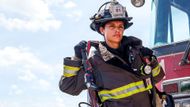The popular TV show Chicago Fire has managed to attract hearts all over the world. The lives of courageous firefighting men and women and paramedics working to save lives are being told here. This show tells you how it feels to be part of a firehouse family with a close view. It has made us wonder one thing: Why Firehouse 51?
Firehouse 51 in Chicago Fire
Firehouse 51 feels like a second home to them. But the name “51” may seem random unless you know how real fire departments name their stations. In this article, we will explore the real-life firehouse naming system. You’ll learn why firehouses are given numbers like 51, and whether Firehouse 51 in Chicago Fire is real or fictional. We’ll also talk about how the show connects to the actual fire department in Chicago.

Is Firehouse 51 a real place?
The most common question asked by many: Does Firehouse 51 really exist? There's no Chicago Fire Department station called "Firehouse 51." Number 51 was made for Chicago Fire, the fictional acknowledgement of a firehouse, but the building seen on the show is real. Exterior shots of Firehouse 51 are shot at an actual fire station.
This station is at 1360 South Blue Island Avenue in Chicago and sits in Engine 18 territory. That has been active for over 100 years. Though it carries no name of Firehouse 51 in reality, it looks almost exactly like the one we have seen on the show. The producers really wanted it because of the great appeal of its red brick facade and its period charm.
Why the number 51?
Now let's review the reasons behind the number a show chose for its firehouse. Officially, the creators have not mentioned this, but many share a theory suggesting that it was an easy-to-remember name that sounds strong and realistic. Real-world fire departments do assign a number to their stations, so the choice of 51 fits right along those lines.

In real cities such as Chicago, firehouse numbers often indicate either the ordinal number assigned during establishment or relate to the district to which a particular firehouse belongs, sometimes also connected to an appropriate organizational setup within the department itself. Number 51 could have been selected to sound authentic and fitting, yet avoid clashing with an active Chicago firehouse.
How do fire departments name their stations in real life?

Most fire stations in the U.S. go by numbers, not fancy names. We’re talking about stuff like “Station 12” or Engine 7. These numbers aren’t just picked out of a hat. It’s all about keeping things from turning into chaos when stuff hits the fan.
The number isn’t just for kicks; sometimes it’s about history, and sometimes it’s about what kind of crew or rig lives there. One building might be home to a whole circus of units, engines, trucks, ambulances, you name it. They’ll each have their own number, but usually, people just call the place by whichever number is stuck on the sign out front.
Understanding the units: Engine, truck, squad
To understand firehouse naming, it's also important to know the difference between the kinds of fire units. Each type of unit has a specific job, and they are all based at different stations throughout a city. An engine company handles the water supply and hoses. They’re usually the first to arrive and put out fires.
A truck company carries ladders and tools used for rescues, breaking into buildings, and reaching high places. A squad is a special rescue unit trained for more difficult or dangerous situations. An ambulance team provides medical help to the injured. All of these are connected to specific firehouses with their own numbers.
The role of districts and battalions
Big cities usually chop up their fire departments into chunks, districts, battalions, or whatever you want to call them. Each one’s got its turf, with a handful of firehouses watching over their piece of the map. They slap numbers on those firehouses, but don’t get too hung up on the logic.

Like Chicago, they’ve split the place into a bunch of fire districts and battalions. Each battalion’s got its own chief, cruising around, jumping into the action when things get wild. Now, about those numbers like Firehouse 51? It totally fits the pattern. With all the old quirks and numbering hangovers, it could slide right in, and nobody would bat an eye. That’s just how this whole system rolls.
How Chicago Fire keeps things real
They’re not just winging it. They actually hang out with real firefighters, poking around firehouses, snagging stories, and probably a few cups of terrible breakroom coffee. The gear? Legit. The jargon? Honestly, this is the kind of chatter you’d catch if you lurked around the firehouse kitchen at 3 a.m.
And yeah, those insane emergencies like blazing infernos, twisted metal from nasty car crashes, the occasional cat-in-a-tree fiasco. They’re not just some Hollywood fever dream. That stuff’s real. Real crews see that kind of chaos in daily life. Firehouse 51 isn’t real, but honestly, it feels close enough. The squad’s got the right look and the right rules, and when that alarm goes off, their scramble feels dead-on.
How Firehouse numbers help during emergencies
The firehouses get numbers slapped on them mostly to keep chaos at bay when stuff hits the fan. You’ve got flames, smoke, sirens blaring, nobody’s got time for long-winded explanations. Just yells out, “Engine 51!” over the radio, and everyone knows exactly who’s rolling out and what they’re supposed to do.
No messing around. It just makes life a lot easier when every second counts. This system is also helpful when many teams respond to the same event. During large emergencies, multiple firehouses might send help. Using unit numbers allows leaders to organize everything quickly.

Firehouse pride and tradition
Another reason firehouse numbers are important is tradition. Firefighters are seriously obsessed with their stations. You’ll see those numbers everywhere, plastered on their shirts, slapped onto the trucks, all over the walls like some weird badge of honor.
Especially in Chicago Fire, Firehouse 51 basically turns into a second home. It is more like a tight-knit family that just happens to be surrounded by fire poles and sirens. And they stick together, celebrate, and grieve together. This is also how real firehouses usually work.
The implications of the number
So, why was Firehouse 51 chosen as the Chicago Firehouse? The number was selected to adhere somewhat to real-life naming conventions but be distinct. While it is not the actual name of any Chicago firehouse, the numbering is consistent with that of fire departments in general.
The building that viewers see on-screen is actually real; the way it operates within Chicago Fire is pretty much parallel to how a real fire service functions.
